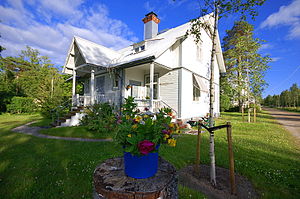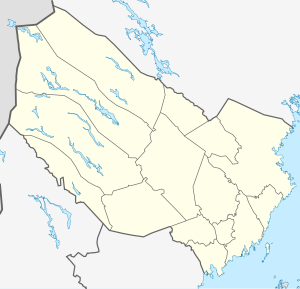Norrbyskär
| Norrbyskär | ||
|---|---|---|
| Former workers' apartment on Långgrundgatan. | ||
| Waters | Gulf of Bothnia , Baltic Sea | |
| Geographical location | 63 ° 33 '0 " N , 19 ° 52' 35" E | |
|
|
||
| length | 3.3 km | |
| width | 900 m | |
| surface | 1.5 km² | |
| main place | Norrbyskär | |
The Norrbyskär are a Swedish group of islands. They are located in the Gulf of Bothnia off Hörnefors at the mouth of the Öreälven in the municipality of Umeå , in Västerbotten County .
The archipelago consists of two larger islands, Stuguskär and Långgrundet and the smaller islands Stengrundet, Blågrundet, Tannskär, Truthällan and Kalmarn. The ferry pier, Norrbyskärs Wärdshus and the former workers 'houses made of brick are on Stuguskär, the sawmill (now a museum), the church and the former workers' apartments made of wood are on Långgrundet .
In 1895, Frans Kempe , the managing director of MoDo , built a steam-powered sawmill and at the same time a workers' settlement for the workers and their families on the Norrbyskären . The sawmill was shut down in 1952 and today the main islands are a popular destination for tourists. The archipelago with its extraordinary industrial and cultural history is a Swedish imperial interest . The easiest way to get to the islands is by ferry from Norrbyn .
history
Håknäs had had a sawmill on the Öreälven since 1750. In 1889 Frans Kempe bought this sawmill for Mo och Domsjö AB. His primary interest was not the sawmill itself, but the logging rights for the surrounding forests. The sawmill on Långgrundet was built in 1895 and named after the disused sawmill in Moliden . In order to provide the new sawmill with labor, apartments, a shop, a school and a health system were built on the islands.
The workers were dependent on the factory management, at the same time they had some great privileges on the islands. Every worker got a free apartment, other privileges depended on the working class to which they belonged. At the beginning of the twentieth century, all apartments were equipped with electric light, which was usually a luxury for the wealthy at the time. Other privileges for the workers were a plowed potato field for the families, wood and access to washrooms and bathrooms. There was also a bakery , a workshop and a school. Frans Kempe succeeded in keeping trade unions away from the islands until 1919, instead he offered workers advantageous conditions through pension, health and emergency funds. The company also had a nurse and midwife on the islands.
However, there was no church for the workers. MoDo paid taxes to the municipality of Nordmaling , but it was a long way to the local church. Therefore Kempe decided to build its own church and found a parish . First a church was built in Hörnefors, and then it was desired to found their own parish. The municipality of Nordmaling was opposed to this, as they did not want to lose a large part of their income. However, the government supported MoDo 's proposal, in 1913 the parish of Nordmaling was divided and 1689 people were assigned to the new parish of Hörnefors.
The heyday of the sawmill on the Norrbyskär was in the 1920s, when almost 1,400 people (workers and their families) lived in the main town of Norrbyskär. Domestic and international competition along with recessions led to a reduction in production in the 1930s before production was completely shut down in 1952. Today nobody lives on the islands all year round.
tourism
Since the 1980s the Norrbyskärs have been used as a tourist destination and for leisure houses. In the summer, artists live here, among others, who return every year. The Norrbyskärs Wärdshus restaurant offers rooms as well as a restaurant. In 1990 the construction of the Norrbyskärs museum started, today it houses photos, exhibitions and a model of the islands as they looked around 1920.
On the eastern side of the island of Blågrundet, the Christian Association of Young People operates rental rooms and a conference facility . Holiday camps are also held here for confirmations .
Web links
- Norrbyskärs Museum website (Swedish)
- Inn, ferry times
literature
- Mats Ahnlund: Norrbyskär - om tillkomsten av ett norrländskt sågverkssamhälle on 1800-talet . Umeå 1978.
- Gudrun Norstedt: Norrbyskär, sågverksön i Bottenhavet . Umeå 1994.
- Adolf Råde: Nordmalings kyrka och församling . 1951.

